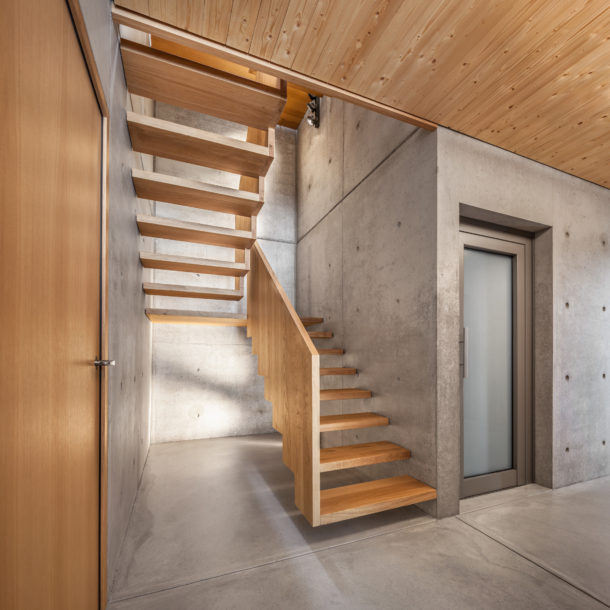
Categories
About Saharchitects
In this blog series, we will cover the different ways the design of your home can make a difference in your health and well-being. Our topic this week is about using natural materials. (Title photo of an Arttek / Saharchitects project in Flaxweiler. Photo by steve troes fotodesign)
There is no place like home to experience the sense of touch. Whether walking barefoot across a stone floor or sitting down at a natural wood table, it is the place we come into the most contact with materials.
Dynamic and changing
The temperatures and textures of the materials in our home have a profound effect on how we feel. When it is cold outside, the warmth of a stone surface that has been baking in the sunlight is irresistible. But that same stone can also give us relief from the heat by storing cooler temperatures from the night.
It is because of the transformative nature of stone that many anthropologists believe it was used as a sacred material in ancient cultures. The texture of the stone changes with weathering and abrasion. A rough stone with sharp edges can be polished into a smooth, round form after being tumbled for years in a river. The complex crystal structure also changes colour and visual form as the light striking it moves and changes.
Karina Croucher notes, “Rather than considering stone to be inanimate, changes in light and temperature suggest that it could be perceived as dynamic, in a changing state, rather than in a constant one. Acts of carving may have been thought to give form to something that was already believed to be within the stone, a topic often debated in relation to rock art or the making of stone tools.”1
Engaging the senses
Materials such as concrete and brick are composed of natural elements, and with varying textures and composition they can have some of the same properties as stone.
Built in mass, concrete can hold temperatures in the way that stone does, and it can be embedded with the pattern of the wood used to form it. This kind of visual pattern has also been shown to reduce stress (see our post from April 4th).
The modularity of brick along with its various colours and textures allows it to be used in interesting ways. We can design complex and stimulating patterns with brick that can engage our senses of sight and touch.
Inducing relaxation
The health and well-being benefits of touching natural materials is something that is intuitively known, but has only recently begun to be researched. In 2013, Koga & Iwasaki demonstrated that touching a real leaf versus a synthetic one created physical relaxation by slowing the blood flow rates in the part of the brain known as the prefrontal cortex.
In research done in 2017 and 2018, touching wood with the hands or feet also significantly reduced prefrontal cortex brain activity relative to other materials and induced physical relaxation.2,3 The way in which the wood is finished makes a difference as well. Unfinished or simply finished wood induces relaxation and decreases heart rate better than coated wood.4
It is clear from all of these studies that our bodies react much more positively to natural materials than to synthetic ones when we come in contact with them. Our sense of touch is very powerful and in our homes it is very important to integrate natural surfaces.
Saharchitects is experienced in understanding how to design with natural materials. If you are considering renovating or building a new home, contact us or follow us to learn more.
References
1. Karina Croucher, Death and Dying in the Neolithic East, Oxford University Press, 2012, pg. 140
2, 3, 4. Harumi Ikei, Chorong Song & Yoshifumi Miyazaki, Physiological Effects of Touching Wood, International Journal of Environmental Research and Public Health, 2017, 2018
#saharchitects #wellbeing #lifeofanarchitect #luxembourg #luxembourglifestyle #nature #naturelovers #greenbuilding #ecofriendly #positivepsychology #happiness #environmentalpsychology #biophilicdesign #residentialdevelopment #immobilier